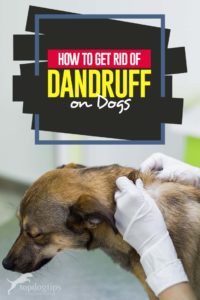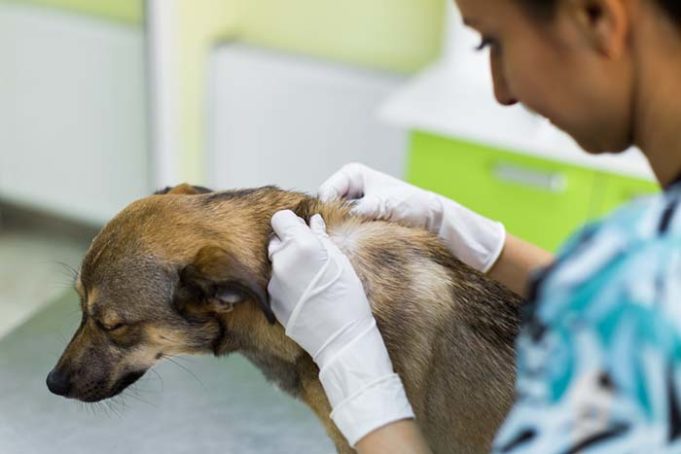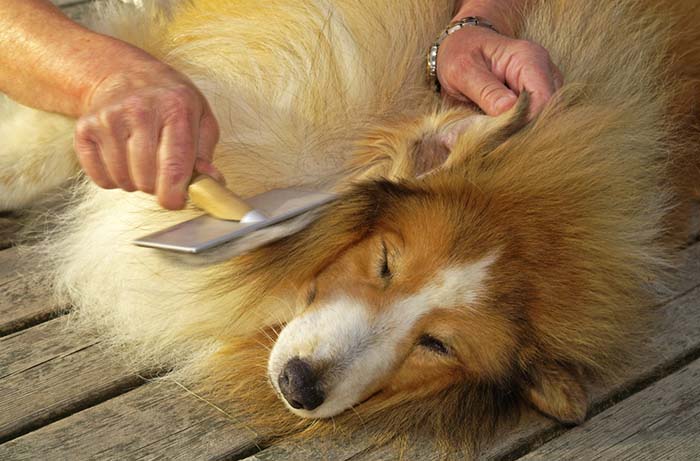Like people, dogs can suffer from dandruff, little white flakes scattered throughout their fur. Dandruff has both primary and secondary causes. Primary one is an inherited trait that is passed down genetically. As a secondary cause, the dandruff may be a symptom of an internal or external parasites, allergies, types of endocrine disorders, bacterial or yeast infections, diet, or environmental factors, like temperature.
It is common and natural for a dog to have some white flakes in their fur most of the time. This can be caused by the change in season, stress, or a change in environment. Only start looking for more concerning causes when a large abundance of white flakes begin to show, especially if the dog never had that much before.
It’s important to take note of any symptoms that may be associated with the dog's dandruff. Check frequently to see if your pup has any irritation or red spots in addition to constant itching or discomfort. These are signs that the dandruff could be caused be something in the skin, like an infection, as genetic dandruff is not normally accompanied by itching or irritation. Another common sign of dandruff in dogs being a secondary cause is an odor coming from the irritated skin or area. Determining which type of dandruff it is determines the steps needed to get rid of it.
Taking the First Steps
Not all dandruff in dogs is caused by an underlying problem, especially when the dandruff is not awful, but rather just mild. There are a few at-home options that can be tried before visiting the vet. They are not guaranteed to work, but may reduce the amount of dandruff enough to determine if the dog is sick or if it is a genetic condition, or a random phenomena.
ALSO READ: 9 Ways to Improve Your Dog’s Skin and Coat Health
How to Get Rid Of Dog Dandruff (Primary)
1. A Balanced Diet
Determine which food is best for the dog by making sure that it contains all the essential vitamins, minerals, and nutrients. Making food at home is not a bad idea and there's a number of homemade recipes good for dog's skin; remember to consult a vet or canine nutritionist before creating meals that may not be giving the dog everything it needs. Also take into consideration any previously discovered allergies the dog may have.
2. Use a Humidifier
Dry air can potentially dry the dog’s skin out, increasing the amount of dandruff they produce. If it is common to have low humidity in the home, try adding a humidifier to constantly run. The best placement would be near the dog’s preferred sleeping area or in the room where your pooch spends the most time in throughout the day.
3. Groom Them Regularly
Keeping the dog well brushed and groomed can help spread the natural oils that their skin produces as well as messaging the skin for better distribution and blood flow. Throwing in a few extra washes can help, dirt is sometimes a large contributing factor to dog dandruff even if they don’t require washing as frequently as people do.
4. Use Oatmeal Or Anti-Dandruff Shampoo
An easy switch is replacing the normal dog shampoo with oatmeal or anti-dandruff shampoo. Studies show and veterinarians agree that oatmeal shampoo is by far the best for dog's skin. It was shown to not only reduce dandruff, but also comforts and soothes a dog’s itchy skin. Do not attempt using people dandruff shampoos as this can make the situation worse.
5. Omega-3 Fatty Acid Supplements
When a solution is not obvious or is not working, try adding supplements into the dog’s diet. Omega-3 fatty acid, best given through fish oil supplements, were shown in studies to support coat and skin health, which reduces the amount of dandruff on the dog. Always consult a veterinarian before adding any vitamins or supplements into the dog’s diet just to make sure.
Treatment for Secondary Dandruff in Dogs
At-home remedies for dog's dandruff may help, but when the situation may be caused by something deeper, it may be better to visit the your vet instead. They may discover something that was previously unknown and unnoticed.
Cause: Allergies
One of the most common causes of dandruff on dogs is environmental and diet allergies. For environmental allergies, medication can be prescribed by the vet to help reduce and potentially remove the reaction. If it is believed to be a diet related allergy, attempt changing food brands and if that does not work, try switching food types. Some dogs are more sensitive to food ingredients than others and may require all-natural dog food.
Cause: Skin Infection
Infections within the skin, for example yeast or bacterial infections, can cause dandruff. Especially when there is the presence of staph. These are not infections that dogs pick up from random places; they already have small portions of them in their skin. When the skin is irritated by an allergen, it can cause the skin to become inflamed and infected, causing dandruff.
Once it has been properly identified, a vet can prescribe topical antiseptics or oral medications. The treatment will depend on the severity of the infection.
Cause: Immune-Mediated Disease
These are conditions that affect the glands in the skin. One condition is a reaction within the immune system that causes inflammation which destroys the oil glands in the skin. The solution is straightforward: replace the missing oils in the skin. Normally to do this the vet will prescribe topical medications or oral medications to reduce the inflammation.
Cause: Endocrine Disorders
Diseases like hypothyroidism or Cushing’s disease can be the underlying causes of dog dandruff. One of the most common causes is hypothyroidism with Cushing’s disease being much rarer. it can still happen and should be looked to when basic treatments are not helping.
 For hypothyroidism, the treatment consists of taking medication (supplements) to replace the depleted thyroid hormone. For Cushing’s, the vet will most likely attempt to reduce the amount of cortisol or steroids that the dog is producing.
For hypothyroidism, the treatment consists of taking medication (supplements) to replace the depleted thyroid hormone. For Cushing’s, the vet will most likely attempt to reduce the amount of cortisol or steroids that the dog is producing.
Is Breed a Concern?
There are no particular breeds that are predisposed to have dandruff. Any dog can develop dandruff over time, regardless of the dog breed. Some breeds are predisposed to having skin conditions that may have dandruff as a symptom, like Golden Retrievers or American Bulldogs. While it may be unpreventable to see dandruff on these breeds, it is a signal that something else may be wrong with the skin.
READ NEXT: How to Use Coconut Oil for Dog Skin Problems














